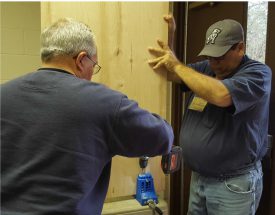
The EcoWall in the IFNH building is an example of a decorative vertical garden. Photo: John O’Boyle
By Steve Yergeau, Rutgers Cooperative Extension, County Agent III/Assistant Professor
Reprinted from Green Knight newsletter, February, 2017.
“Jack jumped up and dressed himself and went to the window. And what do you think he saw? Why, the beans he had thrown out of the window into the garden had sprung up into a big beanstalk which went up and up and up until it reached the sky.” – Jack and the Beanstalk, Old English Fairy Tale
Like the beanstalk, vertical gardens are seemingly bursting on the gardening scene and, like Jack, many people are starting to understand, practice, and reap their benefits, but on a much more manageable scale. Vertical gardening is the cultivation of plants on an upright surface or wall. The plants grown can be decorative (for example, a green wall) or produce used for consumption. The upright surfaces can vary from a solid wall, to an old bookshelf, to a PVC pipe with holes for the plants to grow through, to metal poles that climbing vines and plants can use.
The benefits to using vertical gardening are many, but the biggest is that they allow a grower to maximize limited space, especially when it is at a premium in a very tiny area. This is especially advantageous in urban areas where gray spaces usually outnumber green spaces. A traditional community garden in an urban area can range from a few hundred square feet to a few thousand square feet. A vertical garden, on the other hand, can be as small as a few square feet and still provide environmental and health benefits from getting fresh produce.
What is happening in Ocean County? Without any cows to trade for magic beans, the underserved and vulnerable communities in Ocean County are particularly susceptible to health issues associated with poor access to nutritional food choices, making areas of the county a food desert. The United States Department of Agriculture (USDA) defines food deserts as “urban neighborhoods and rural towns without ready access to fresh, healthy, and affordable food. Instead of supermarkets and grocery stores, these communities may have no food access or are served only by fast food restaurants and convenience stores that offer few healthy, affordable food options.”

Rutgers Master Gardener of Ocean County volunteers construct one of the vertical gardens. Photo: Susan Servidio, Ocean County Horticulturist
To try to counter this situation, educators from many organizations conduct programs such as mini-lessons on healthy food choices at schools. However, school districts face the challenges of limited funds for project-based learning and a decreasing amount of green spaces for growing produce that could supplement these efforts. Staff at Rutgers Cooperative Extension in Ocean County collaborated to assist in correcting this situation through the “Growing Healthy in a Food Desert: Vertical Garden Education Program.” This unique collaboration in Ocean County spans the three departments within Rutgers Cooperative Extension (Agricultural and Natural Resources], 4-H Youth Development [4-H], and NJ Supplemental Nutrition Assistance Program-Education [NJSNAP-Ed]) to implement a vertical garden educational program. Rather than utilize a traditional school garden, the project partners will work with two schools to plan, plant, and maintain a vertical garden in their classrooms. The program will assist schools with addressing the challenges they face by bringing vegetable gardens into the classroom and providing hands-on educational opportunities on horticulture and healthy eating.
So far, SNAP-Ed educators have provided educational classes to Lakewood Middle School and the Hugh J. Boyd Elementary School (Seaside Heights, NJ) on topics such as smart choices for healthy eating and which parts of the vegetables grown are edible. This year, Ocean County staff and Rutgers Master Gardeners are installing two mobile vertical garden units and teaching students to grow their own produce. Students, and participating teachers, will be trained on proper care of plants, maintaining soil health, and proper watering of produce. In addition, students will monitor the growth of their plants and how much produce is grown in each vertical garden. This information will be used to help improve the use of vertical gardens as the program expands to other schools in the future.
By involving educators and students in active education on issues at hand for underserved communities, they become invested in the future sustainability of local resources. The program hopes to help the diverse population in Ocean County adapt to a changing landscape while improving their lives with an educational and action-oriented process that uses science-based knowledge to improve their health and well-being.

